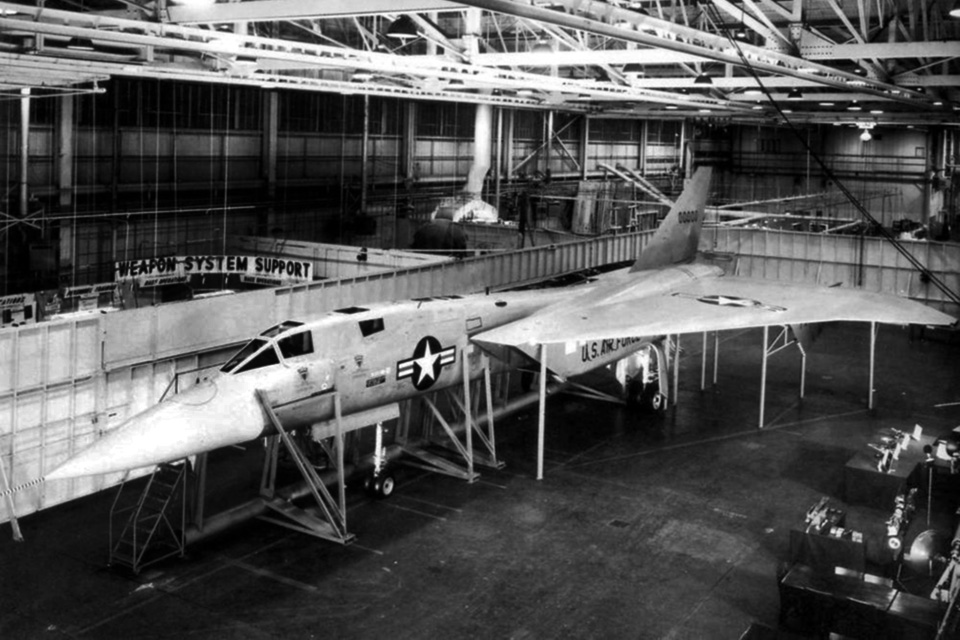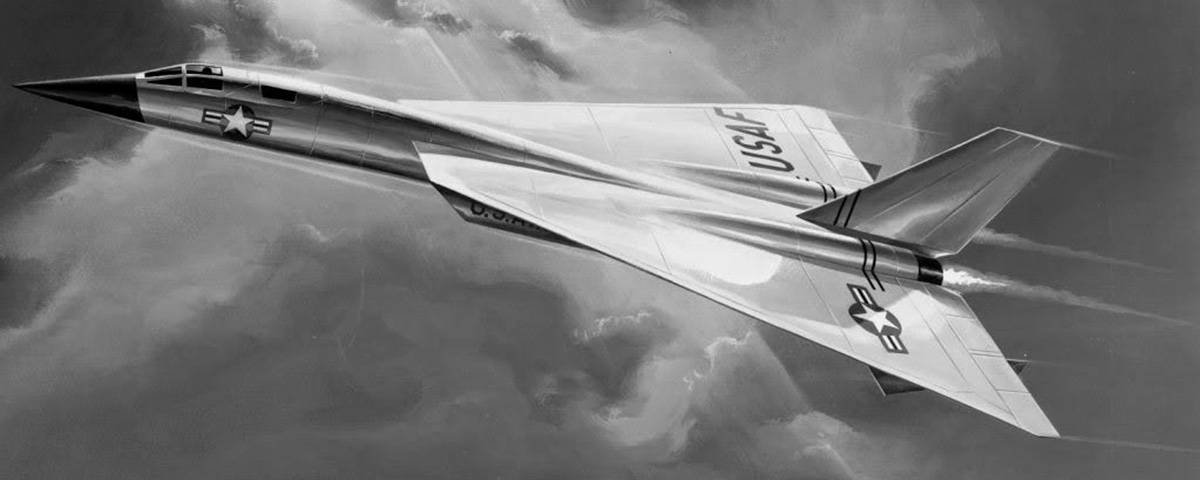Before the missile age, when nuclear deterrence depended solely on aircraft, speed meant everything. You needed it not just for striking the enemy’s homeland with impunity, but also to stop the bombers invading your own airspace before they could obliterate your cities. By the late 1950s, the U.S. Air Force thought it had the former requirement under control. Convair’s Mach 2 B-58 Hustler medium bomber was coming into service, while North American Aviation was developing the bigger and even faster XB-70 Valkyrie, a bomber that could fly at Mach 3 and altitudes that, it was hoped, would render it invulnerable to Soviet defenses. But what about stopping Soviet bombers attacking the United States?
As early as 1949, the Air Force had realized the need for an interceptor capable of shooting down the intercontinental bombers the Soviet Union was presumed to be building. But the jet fighters of the day flew too low and slow to do the job, so generals sought an “ultimate interceptor” that could reach at least Mach 2, preferably even Mach 3, at 60,000 feet or higher. The plan was for the interceptor to scream aloft from bases in the U.S. or Canada and hit Soviet bombers as they came over the North Pole, long before they reached inhabited territory. Throughout the 1950s, various proposals for such a plane, including both original designs and modifications of existing aircraft such as the Northrop F-89 Scorpion and McDonnell F-101 Voodoo, were submitted, analyzed, debated—and finally rejected due to cost, practicality or politics.
But powerful forces in the USAF continued to champion the concept, and on October 6, 1955, the Long Range InterceptorExperimental (LRI-X) program was approved, with Lockheed, North American and Northrop invited to submit preliminary designs. North American’s concept, dubbed the NA-236, won the competition—just in time for the LRI-X program to be canceled in May 1956, a victim of seemingly endless wrangling within the Air Defense Command over budgets and aircraft specifications.
The generals and competing commands finally worked out their differences, and the project was reinstated in April 1957. As the winner of the previous LRI-X competition, North American was awarded a contract to build two prototype aircraft, to be designated F-108As. The ever-fluid requirements were now firmly set: The F-108 would be a Mach 3 interceptor capable of reaching 70,000 feet with a flight radius of more than 1,000 miles. It would carry a two-man crew—a pilot and a weapons officer seated in tandem—and be armed with air-to-air missiles and the latest state-of-the-art electronic fire-control system.
North American was used to thinking far ahead with radically innovative designs—it was also busy building the X-15 rocket plane around the same time—but like any other successful aircraft manufacturer and defense contractor, it also knew how to be pragmatic and economical. Its winning LRI-X design looked a lot like the XB-70 Valkyrie, which made sense, since both had been conceived to overcome essentially identical aerodynamic challenges. North American proposed saving time and money by combining the development and building effort for both aircraft. What worked for one plane would work for the other, whether it was the special materials needed for Mach 3 flight, construction techniques, engines and other systems, or cockpit layouts. As a bonus, North American suggested the F-108 could also serve as an escort fighter for the Valkyrie. It was a “more bang for the buck” proposal all the way around.
The Air Force wasn’t completely sold on the escort fighter idea, but the F-108 certainly seemed to fit the bill for the longrange interceptor, so North American got the green light to move ahead with development, with an eventual order of at least 500 aircraft expected. In May 1959, the company dubbed the F-108 the “Rapier,” echoing the edged-weapon moniker of its earlier aircraft, the F-86 Sabre, and emphasizing the cutting-edge nature of its design.
Like the Valkyrie, the Rapier would be a futuristic design in almost every respect. Its blazing speed and altitude capabilities were only the beginning. As the design evolved it lost some of the distinctive details that made it look so similar to the Valkyrie (such as the canard just aft of the cockpit), but the Rapier retained its sleek, thin profile, just under 90 feet in length with a 58-foot-wide delta wing, sporting wingtips that jutted out at a shallower angle. Building the F-108 called for new techniques and materials, including stainless-steel honeycomb panel construction that would also be successfully adopted on the Valkyrie. An advanced Doppler pulsed radar fire-control system built by Hughes Aircraft would enable the Rapier to find and track its prey, while three Hughes GAR-9 nuclear-capable Falcon air-to-air missiles would deliver the sting. Two General Electric J93 turbojet engines also powered the B-70, although the bigger Valkyrie carried six of them.

The Rapier also featured a highly innovative escape system for its two-man crew. Since popping open a canopy and successfully bailing out of an aircraft hurtling along at almost 2,000 mph above 70,000 feet was an iffy proposition at best, the F-108 would have individual escape capsules. If trouble struck, an internal door would slide up over each cockpit, completely enclosing the crewman, and the entire “clamshell” capsule could be ejected out the bottom of the plane, parachuting safely to the ground as an airbag inflated to soften the impact. During an in-flight emergency, the crew could even button up the capsules without ejecting, maintaining limited control over the airplane, then “unescapsulate” when the trouble was over. The escape capsule idea had originated with the Republic F-103, the Air Force’s previously rejected Mach 3 interceptor candidate, then revived for the Rapier and Valkyrie. (The escape system ultimately proved its mettle in 1966, when a Valkyrie test aircraft was struck midflight by an escort plane and crashed. The pilot, who ejected in his capsule, survived.)
But the F-108 never made it off the drawing board. The Rapier would exist only as a full-size wooden model, along with partial mockups of the forward fuselage and the cockpits, constructed for inspection by Air Force brass in January 1959. The generals were impressed, but not enough: In September 1959, they canceled the F-108, citing development costs.
More than just budgetary considerations doomed the Rapier, however. As the 1950s merged into the 1960s, the nightmare Armageddon scenario evolved—hordes of Soviet bombers coming over the pole and intercontinental ballistic missiles raining down from space, a threat no airplane could counter. Projects like the F-108 and B-70 soaked up dollars sorely needed for America’s own ICBM programs. And manned aircraft were vulnerable, a truth painfully demonstrated by the surface-to-air missile that downed Francis Gary Powers’ U-2 in 1960. ICBMs were cheaper, faster and more reliable than manned bombers, and couldn’t be shot down.
These harsh realities ultimately doomed both the F-108 and the B-70 before they could realize their full potential. Although the Air Force continued to push for the Valkyrie, President John F. Kennedy’s defense secretary, Robert McNamara, killed the program, funding only two prototypes.
Still, the F-108 Rapier’s legacy reached far beyond the few years of its developmental life. Its Hughes-developed radar and weapons systems soon found their way into the Lockheed YF-12, another Mach 3 project that metamorphosed into the SR-71 reconnaissance aircraft, which remains the only Mach 3 plane that ever actually went into production. And North American adapted much of the F-108 work into its A-5 Vigilante fighter-bomber, a carrier-based Mach 2 plane that eventually saw extensive combat and recon service during the Vietnam War.
Luckily the F-108 Rapier was never needed to fulfill its original purpose of stopping Soviet nuclear bombers. But as often happens with aircraft a little too far ahead of their time, some of its genes survived and found their way into the next generation of military aircraft.
Originally published in the September 2010 issue of Aviation History. To subscribe, click here.





